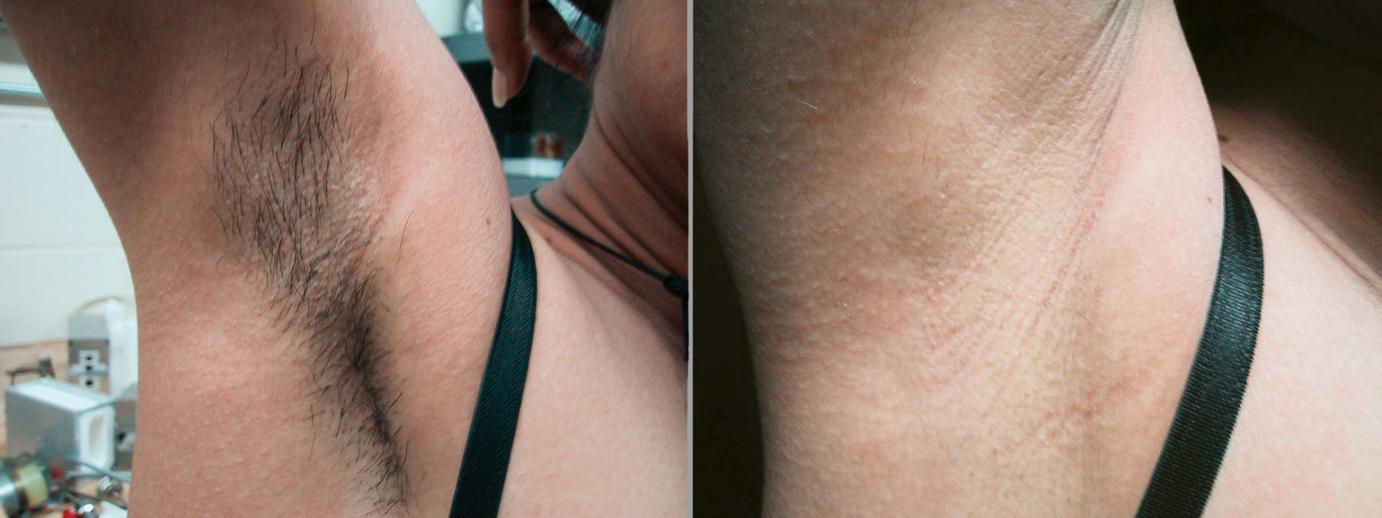Laser Hair Removal - Patients ask, Dr. Ringpfeil answers
Please feel free to use the blog below to share information about Laser Hair Removal or to ask Dr. Franziska Ringpfeil a question that might be of interest to others.
Written by Dr. Ringpfeil
One of the most common hair removal procedures is underarm laser hair removal for women. As the treated area is small, a $400-$600 can reduce, and sometimes eliminate, the need to shave or vax this area.

Laser hair removal for the legs is very popular. After years of repeat shaving and waxing women and men can not go a series of laser treatments that will save them the time, pain, and cost of the other alternatives. After 4-6 treatements over 90% of the hair is removed permanently. If some hair "shows up" after the first series of treatment, it is sparse and fine, usually not noticeable, and can be easily removed by infrequent shaving or additional laser treatments

Please feel free to use the blog below to share information about Laser Hair Removal or to ask Dr. Franziska Ringpfeil a question that might be of interest to others.
# of surveys: 4187
Last updated: 1/02/2024 11:10 AM
the coutersy and attentiveness
#12025-01-24Dr Ringfell was very attentive to my problem. She reviewed my medical history throughly unlike any other physician that I have met before. I felt that she aswered to all my questions with extreme knowledge and confidence. I am leaving my appointment today reasured that she will find the right diagnosis to my problem.
#22025-01-15good service
#32025-04-07I thought it was great, especially when compared to other dermatologists I have been to! Very professional and knowledgable.
#42025-08-15I like the dermatologist's bed side manner and I get the impression she keeps up with the latest treatment options.
#52025-05-27The Dr. is very personable.
#62025-08-14Dr. Ringpfeil was great. She answered all concerns and questions extremely professionally.
#72025-08-04The information provided by the physician was very helpful and useful. I would gladly do what she recommended.
#82025-05-28All
#92025-10-24The office has a very relaxed setting this was the most comfort that I ever felt going to any doctors office, and also great music, you guys we here from me around the holidays and after my outcome with the other specialist!!! Thanks again!! Service AAAAA+++++++++
#102025-05-24Keep doing what you are doing now..make sure no one slips, then I will make sure I write about it.
#12025-11-05beethoven & mahler symphonic music pumped N2 waiting area* squash magazine & velonews & roleur periodical*(my wish list JK)
#22025-10-10I do not like waiting long periods of time in either the reception area or exam room fort he Dr to come in. The exam with the Dr should be relatively close to the appointment time
#32025-05-02I was a bit embarressed by not knowing more information regarding my parents history. I believe it would have been better handled if I were asked to please get more info and then let the dr's office know.
#42025-07-20give me choices of what type of medicines that i can take
#52025-07-21Do no change
#62010-08-19 14:48:13I can't think of anything.
#72010-08-25 14:18:06Talk a little slower
#82011-09-12 11:44:23Very satisfied. Should get an office in Cherry Hill, NJ
#92025-06-23Service was excellent!
#102010-09-30 13:09:12
I’m a very hairy female. My body has hair bumps all over the place. Is there anything i can do about this?
Hair bumps (pseudofolliculitis) are caused by coarse, terminal hair. This type of hair is typically found in the beard area of men and in the genital area of both genders. In some women, excessive hair growth can lead to terminal hair on other body parts.
Pseudofolliculitis can occur spontaneously but more frequently it is associated with shaving.
If a hormonal abnormality leads to excessive hair growth in a woman, medical treatment should be started at time of any hair removal method.
The best method for permanent hair removal of large areas is laser hair reduction. It may not remove 100% of your hair but after several sessions any remaining hair is so fine that pseudofolliculitis does not occur anymore.
I have had several treatments over the last 6 years and havent had anything in the last 2 I tried 2 doctors and the results were poor i was hair free for only 8 weeks will this laser be stronger it was called cold laser that i had prior.
One of the most efficient lasers for hair reduction is an Alexandrite laser, e.g Gentlelase. It works best on fair skin with dark hair. In individuals with a tan or Mediterranean and darker skin, laser assisted hair reduction is most efficient with an Nd:YAG laser. Other devices used for laser hair reduction include diode lasers and IPL (intensed pulsed light). These are considered less efficient.
The initial process of reducing hair by laser requires typically 3-6 treatments. During the very first treatment, the hair falls out indiscriminately. This primes the hair to be in a vulnerable state at the time of the second treatment 4-6 weeks later. With every subsequent treatment, more hair gets permanently destroyed. Biannual or annual maintenance treatments are performed to address any hair that had been dormant during the initial treatment period. If maintenance treatments are not performed regularly, sometimes 2 treatments may be needed to achieve permanent reduction of hair that occurred since the initial treatment. The first treatment will shed the hair indiscriminately and the second will then destroy the primed vulnerable hair.
Cold lasers as defined by the FDA as low level energy lasers are not typically used for laser assisted hair reduction. Their strengths is in pain reduction and even promotion of hair growth. I believe, that there is a misunderstanding about the type of laser used in your initial treatment.
I was told that Laser was not effective on dark skin. I am african American with medium brown skin. I have hairs in my chin and also upper lip, which is very annoying. Please let me know if this is so, and could it be done on a permanent basis. It would also be important if you would let me know the price
The Nd:YAG laser is safely and also effectively used on darker skin (Mediterranean, Indian, African etc.) as long as the hair is not white. Hair cannot be plucked, threaded or waxed four weeks before the laser treatment, but bleaching, clipping or shaving is okay during this time. The day before the treatment the hair should either be shaved or clipped closely. On average, 5-6 treatments are needed to remove hair permanently, and they should be spaced 4-6 weeks apart for best results. Maintenance treatments are sometimes needed between once every 6 months to every 3 years because our body keeps some of our hair follicles in a dormant state. Dormant hair cannot be destroyed by any laser. When dormant hair follicles “awake” and start producing hair again, this hair can be targeted by laser, hence the need for maintenance treatments. In our office we charge $75 for each treatment of chin and upper lip. There is unfortunately no effective laser for white or grey hair on any skin type yet. Those who have just a few stray, white or grey hairs usually chose electrolysis to remove them.
I am interested in knowing the cost for the laser hair removal for the full back.
Laser hair reduction on the back typically takes 5-6 treatments every 4-6 weeks. During this time, 90% of the hair is permanently removed and any remaining hair becomes so fine that it is usually not bothersome.
Maintenance treatments may be needed as often as every 6 months or as little as every 3 years to treat hair follicles that had been dormant at the time of the initial treatment. We currently charge $675 per treatment of the entire back and $400 for the treatment if only the upper back is of concern.
I am curious: Can laser hair removal be combined with Electrolysis? For instance, can one receive a laser treatment and then follow-up the removal process with electrolysis?
Yes these procedures can be combined.
I’m a lighter-skinned brunette with hair on my upper lip & chin that runs the gamut from very dark to blond. Also, the hair on my lower arms is unpleasantly long and ashy brown. How do you suggest treating these three areas?
If your goal is long term hair removal, I would use a combination of laser (darker hair) and electrolysis (lighter hair) on your upper lip. The forearms can be treated by laser if the hair is in fact brown. Other options include a prescription cream for the upper lip, which is used daily but is independent of hair color.
I am interested in permanent hair removal on my chin but could not possibly go a month without tweezing. I need to tweeze every day. Are there any options for me?
The short answer is no. However, you could consider a daily appointment for electrolysis (except weekends). This is certainly very costly and inefficient, yet the only way to do it permanently while avoiding the need to pluck. You should be evaluated by our esthetician. Perhaps a slightly more efficient way can be worked out.
Do you offer any form of a guarantee for your treatments?
During a consultation you are expected to learn about options for hair removal for your type of skin and hair. We will recommend a specific treatment regimen for you. Individual circumstances will let us predict your treatment success and we will discuss this with you prior to treatment. As you may have learned from our website, laser hair removal is an effective procedure. In general, it removes about 90% of hair after 6 treatments when regularly spaced every 4-6 weeks. A portion of your hair follicles is dormant at any given time, including at the time of laser hair removal.
Dormant hair follicles do not get destroyed by laser or any other technology available to this date. You may benefit from periodic maintenance treatments as often as every six months or as little as every 3-4 years if there is a little more hair than at the end of your treatment series and if it is bothersome.
Hi,
I have dark nasal hairs and want them permanently removed with Laser .. can this be done? Thank you
I am afraid to say that it appears not feasible at this time as the lasers that are currently available for laser hair reduction do not have a small enough spot size to enter the nares.
I would like to do my upper lip and chin also but cannot go a month without plucking. I have dark hair and a lot of growth. Is it possible to bleach it at least?
Bleaching can certainly be done in preparation for and in between laser hair treatments. Other allowed modalities are shaving and clipping.